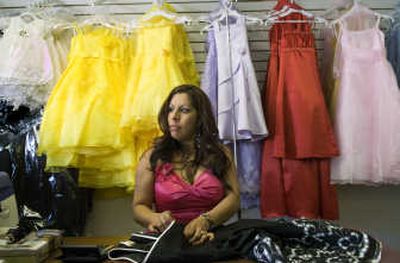Latinos, Pasco on the rise

PASCO – Herlinda Zambrano spent eight years working agriculture and cleaning jobs until she was able to save enough money to afford her dream: her own dress shop where she doesn’t have to take orders from anybody.
While working toward her dream, she returned to her native Mexico to bring her son and daughter back into her new life in a land of opportunity. Now her family and many others like hers have transformed this southeast Washington agricultural town into a city of 50,000 residents, more than half of whom are Latino.
As these new immigrants and their descendants have prospered, so has Pasco. Its downtown, once at risk of dying as retail businesses moved out, now thrives because of entrepreneurs like Zambrano, who was able to begin living her dream with a $10,000 investment.
Her shop, “Mi Gusto Es,” sells dresses and formal children’s clothes for first Communions and quinceaneras, the coming-out celebration for teenage girls.
Zambrano is able to provide a living for her family and a little something extra to send back to her mother in Michoacan state in southern Mexico.
Many Pasco residents celebrate this new diversity each September at the Fiery Foods Festival. This weekend an estimated 5,000 to 7,000 people will fill downtown streets, buying fresh produce and Mexican food and dancing to the music of a nine-piece salsa band.
While Latinos make up about 8.9 percent of Washington’s total population, Franklin County has become the state’s first majority Latino county, with about 57 percent of its 64,200 population claiming Latino heritage, according to the state Office of Financial Management. Neighboring Adams County, with 17,300 people, is 52 percent Latino.
Meanwhile the state’s Latino population is projected to grow 150 percent to more than 1 million residents by 2030, faster than any other minority population and nearly 4 1/2 times faster than the expected growth of white population.
When the celebration began 23 years ago, it was known as the Pasco Autumn Festival, said Dorothy Schoeppach, co-chairwoman of the festival. She said the name was changed to make the event more inclusive. The town’s farmers’ market now includes not only Anglo vendors but Latino farm owners.
“We’re looking to get both segments of the population involved in this,” said the event’s other co-chairwoman, Gloria Garcia. She moved to Pasco from Southern California 13 years ago when her husband, Gregory Garcia, was hired as fire chief.
Pasco’s growth in population has been accompanied by a boom in housing and enrollment in the Pasco School District.
When former assistant principal Salvador Beltran came to Pasco High School in 1986, there were about 160 students, less than 18 percent Latino. When he retired in 1997, there were 2,000 high school students, more than 40 percent Latino, Beltran said.
In 2006, voters approved bond issues to expand Pasco High School and build a second high school to accommodate total districtwide enrollment of 12,827 students, 560 more than last year. About 65 percent of students come from homes where English is not the primary language.
The Latino population has grown here as farm workers followed the migrant stream through Texas and California into Washington’s fruit basket and found permanent jobs, said Cruz Gonzalez, interim vice president for diversity and outreach at Columbia Basin College.
Gonzalez”s own family history is typical. He was born into a migrant worker family from Mexico. When Gonzalez was 4 years old, his family settled in Connell, Wash., where his father found full-time work at Lamb Weston, a food processor.
“It allowed me to stay at one school and to get an education,” said Gonzalez, who graduated from Connell High School and received an accounting degree from Central Washington University.
When people think of high Latino populations, Gonzalez said, they think of high poverty rates or low academic achievement, but this does not have to be the case. By the second and third generation, Latinos are able to overcome the barriers of language and acculturation to succeed and become prominent members of the community, he said.
Downtown Pasco storefronts with names like Bianca’s Fashion Zapateria and Viera’s Bakery-Panaderia reflect this transformation.
More than two years ago, Gonzalez worked for the Tri-Cities Development Council in minority business recruitment and development, providing assistance with marketing plans, merchandising and bookkeeping to mostly Spanish-speaking business owners.
“What I tried to teach them was to identify their market and to revamp their marketing plan to include everybody,” Gonzalez said. “The bottom line is not who they sell to, but the profit margin, which knows no color but green.”
The rapid growth, among the fastest in the state, has presented Pasco with challenges, according to Officer Rodrigo Pruneda, a Police Department spokesman, but the city has met them.
In the past five years, Pruneda said, crime has not increased, thanks in part to 15 new officers who have been added to the force in that time. Fire and emergency services employees also have been added in significant numbers, he said.